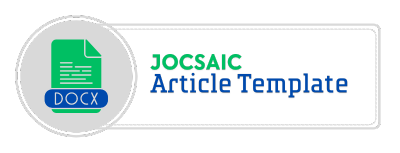Classification of Customer Credit Risk Levels Using the Random Forest Method: A Case Study on Microfinance Institutions
DOI:
https://doi.org/10.64803/jocsaic.v1i2.20Keywords:
Credit Risk, Classification, Random Forest, Microfinance Institutions, Machine LearningAbstract
Credit risk classification plays a crucial role in supporting financial institutions, especially microfinance institutions, in assessing the ability of customers to repay loans. This study aims to develop a credit risk classification model using the Random Forest method, which is known for its accuracy and robustness in handling classification problems. The research uses a dataset obtained from a microfinance institution consisting of various customer attributes such as income, age, loan amount, repayment history, and employment status. The dataset is preprocessed and divided into training and testing sets to evaluate model performance. The Random Forest algorithm is then applied to build a classification model that categorizes customers into three credit risk levels: low, medium, and high. The results show that the Random Forest model achieves a high level of accuracy, with a classification precision of 89%, recall of 87%, and F1-score of 88%. These findings indicate that Random Forest is an effective technique for credit risk classification and can be implemented by microfinance institutions to support better decision-making in credit approval processes. This research also highlights the potential of machine learning techniques in enhancing credit risk management and minimizing non-performing loans.
Downloads
References
[1] O. A. Bello, “Machine learning algorithms for credit risk assessment: an economic and financial analysis,” Int. J. Manag., vol. 10, no. 1, pp. 109–133, 2023.
[2] M. Naili and Y. Lahrichi, “The determinants of banks’ credit risk: Review of the literature and future research agenda,” Int. J. Financ. Econ., vol. 27, no. 1, pp. 334–360, 2022.
[3] F. Ofria and M. Mucciardi, “Government failures and non-performing loans in European countries: a spatial approach,” J. Econ. Stud., vol. 49, no. 5, pp. 876–887, 2022.
[4] H. El-Nasharty, “The role of microfinance in poverty reduction: Countries experiences by regions 2000-2018,” Innov. J. Soc. Sci. Econ. Rev., vol. 4, no. 1, pp. 1–9, 2022.
[5] N. A. Abasimel, “Islamic banking and economics: concepts and instruments, features, advantages, differences from conventional banks, and contributions to economic growth,” J. Knowl. Econ., vol. 14, no. 2, pp. 1923–1950, 2023.
[6] M. L. Siraj, S. Syarifuddin, A. C. T. Tadampali, H. Zainal, and R. Mahmud, “Understanding Financial Risk Dynamics: Systematic Literature Review inquiry into Credit, Market, and Operational Risks:(A Long-life Lesson From Global Perspective to Indonesia Market Financial Strategy),” Atestasi J. Ilm. Akunt., vol. 7, no. 2, pp. 1186–1213, 2024.
[7] I. R. Candraningrat, V. I. Dewi, N. Abundanti, N. W. Mujiati, and B. Zaman, “The Micro, Small and Medium Enterprises Financing Based on Financial Technology,” JIA (Jurnal Ilm. Akuntansi), vol. 7, no. 2, pp. 329–345, 2022.
[8] R. Alanazi, “Identification and prediction of chronic diseases using machine learning approach,” J. Healthc. Eng., vol. 2022, no. 1, p. 2826127, 2022.
[9] M. M. Rahaman, S. Rani, M. R. Islam, and M. M. R. Bhuiyan, “Machine learning in business analytics: Advancing statistical methods for data-driven innovation,” J. Comput. Sci. Technol. Stud., vol. 5, no. 3, pp. 104–111, 2023.
[10] M. Muhajir and J. Widiastuti, “Random forest method approach to customer classification based on non-performing loan in micro business,” J. Online Inform., vol. 7, no. 2, pp. 177–183, 2022.
[11] L. Gao, G. Li, F. Tsai, C. Gao, M. Zhu, and X. Qu, “The impact of artificial intelligence stimuli on customer engagement and value co-creation: the moderating role of customer ability readiness,” J. Res. Interact. Mark., vol. 17, no. 2, pp. 317–333, 2023.
[12] J. J. Xiao and K. T. Kim, “The able worry more? Debt delinquency, financial capability, and financial stress,” J. Fam. Econ. Issues, vol. 43, no. 1, pp. 138–152, 2022.
[13] A. Yadava, “AI-Driven Credit Risk Assessment: Enhancing Financial Decision-Making in SME Lending Using Deep Learning Algorithms,” Int. J. Innov. Res. Comput. Commun. Eng., vol. 11, no. 13, pp. 10–15680, 2023.
[14] E. O. Alonge, N. L. Eyo-Udo, B. C. Ubanadu, A. I. Daraojimba, E. D. Balogun, and K. O. Ogunsola, “Developing an Advanced Machine Learning Decision-Making Model for Banking: Balancing Risk, Speed, and Precision in Credit Assessments,” J. details pending, 2024.
[15] J. R. de Castro Vieira, F. Barboza, D. Cajueiro, and H. Kimura, “Towards Fair AI: Mitigating Bias in Credit Decisions—A Systematic Literature Review,” J. Risk Financ. Manag., vol. 18, no. 5, p. 228, 2025.
[16] A. Gupta, R. K. Singh, and S. Gupta, “Developing human resource for the digitization of logistics operations: readiness index framework,” Int. J. Manpow., vol. 43, no. 2, pp. 355–379, 2022
Downloads
Published
Issue
Section
License
Copyright (c) 2024 Fera Damayanti, Arief Budiman, Siti Sundari, Theodora MV Nainggolan (Author)

This work is licensed under a Creative Commons Attribution-ShareAlike 4.0 International License.









